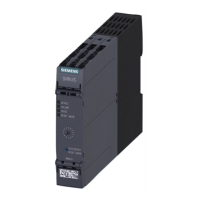Description
3.5 Functions
SIRIUS 3RM1 motor starter
30 Manual, 11/2013, A5E0345285095020A/RS-AB/002
The fault state is indicated by LEDs and the fault signaling output.
Damage due to asymmetrical current consumption by built-in brakes
When connecting and operating motors with built-in brakes, the energy for releasing the
brakes is taken from the motor connection cables. This can result in substantial asymmetry
in power consumption.
Observe the following measures for all 3RM1 motor starters:
• If the current for the braking facility is taken from two phases, connect the motor cables
that are additionally loaded with braking current to terminals T1 and T3. Observe the
additional braking current when setting the motor current.
• Alternatively, the braking facility can be fed externally.
A further braking facility is possible for 3RM10 and 3RM12 Standard motor starters:
• If the current for the braking facility is taken from just one phase and the neutral
conductor, connect the motor cable that is loaded with the braking current to terminal T2
of the motor starter.
Do not use 3RM11 Failsafe and 3RM13 Failsafe motor starters for such braking
Damage from incorrect connection
Incorrect connection of the motor can result in damage.
Connect the motor as specified in the typical circuit diagrams.
You can find circuit diagrams for operating motors with brakes in the chapter "Typical circuits
(Page 143)".
Thermal calculation method (motor memory module)
Principle of operation
The electronics continuously calculate a model of the thermal load on the motor dependent
on the operating time and the current load. The motor memory module charges when the
motor is switched on. The motor memory module discharges after the motor is switched off.
Following an overload tripping operation, the motor memory module is fully discharged after
approximately three minutes. You must wait for this cooling time to elapse before you can
acknowledge the fault. If the control supply voltage fails, the 3RM1 motor starter stores the
remaining cooling time. When the control supply voltage is restored, the remaining cooling
time elapses before the motor can be switched on again.
If you initiate a restart within a very short time after switching off the motor, it may be that the
motor memory module has not yet fully discharged. This can result in an extremely fast
overload trip after the restart. During continuous operation ("Warm" motor memory module),
tripping times are reduced depending on the prior load.

